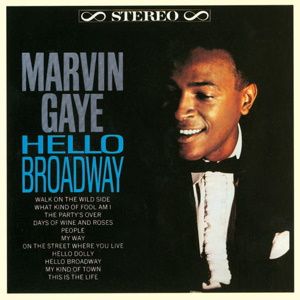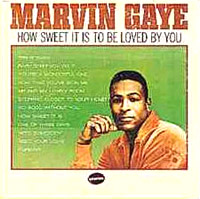Marvin Gaye was a Motown recording artist who either solo or in duet with several female singers released some popular singles in the Sixties, such as "I Heard It Through the Grapevine", "How Sweet It Is To be Loved By You", "Ain't No Mountain High Enough", and "Ain't Nothing Like the Real Thing". In the Seventies, influenced by Curtis Mayfield, Isaac Hayes and Norman Whitfield, he released the critically acclaimed What's Going On album, and - amongst some poorer quality albums, Let's Get It On, and in 1982 Midnight Love, his best selling album, which contained the track "Sexual Healing".
A somewhat shy and troubled individual who had a difficult relationship with his father; at the end of his life, plagued by huge tax debt and struggling to overcome drug dependence, he moved back in with his parents, and was shot dead by his father.
Gaye's reputation rests largely on the Let's Get It On and, in particular, the What's Going On albums. Though he derived the ideas and sounds for those albums from other artists, his commercial success made it seem as though the ideas were his, and so he is credited with introducing or promoting new soul sounds such as disco, funk and smooth soul, and for bringing social and sexual awareness to black music. Acclaim for his albums appears to be somewhat overstated, though his commercial appeal cannot be denied, and he did help promote the smooth soul sound and influence other artists in that genre. A dubious honour.
 |
| The Soulful Moods of Marvin Gaye (1961) |
Debut album released June1961 as the second LP by Motown. Mostly consisting of standards, "My Funny Valentine", "Witchcraft", etc, the album is a little plain, but it indicates that the 21 year old had a pleasant voice and a good sense of modulation. Rating: 2
 |
| That Stubborn Kinda Fellow (1962) |
Gaye's second album, released Dec 1962, is a significant step forward from the first. Six of the 10 songs were co-written by Gaye, including "Hitch Hike", his first top 30 hit, "Pride and Joy", his first top 10, and "Wherever I Lay My Hat (That's My Home)", a later hit for Paul Young. Rating: 3
 |
| When I'm Alone I Cry (1964) |
 |
| Marvin Gaye & Mary Wells Together (1964) |
 |
| Hello Broadway (1964) |
 |
| How Sweet It Is To Be Loved By You (1965) |
 |
| A Tribute to the Great Nat "King" Cole (1965) |
Another attempt at being a singer of standards. This is a strong album of its type - Gaye is a competent singer, and handles these songs well. But there's nothing really distinctive here. If you like these songs, you'll find this a pleasant album, but you won't be excited or disturbed. Rating: 3
 |
| Moods of Marvin Gaye (1966) |
 |
| Marvin Gaye & Kim Weston Take Two (1966) |
Another Motown cash in album. The single "It Takes Two", a duet with Kim Weston, was a top 20 hit in May 1966, so this album of songs by Motown staffers sung by the pair was released in August. Rating: 2
 |
| Marvin Gaye & Tammi Terrell United (1967) |
Motown liked teaming up their singers, and felt that Gaye worked well with a female partner. His previous two partners had both left the label, so Motown selected Tammi Terrell, who had some moderate success with the label, but no big hits. Their first single, "Ain't No Mountain High Enough", was a hit, and though they initially recorded separately, the pair developed a good working relationship, especially in live performances, where Terrell's confidence and sex appeal helped the shy and awkward Gaye.
 |
| Marvin Gaye & Tammi Terrell You're All I Need (1968) |
After another Greatest Hits album, a second album with Tammi Terrell was released in August 1968 with top ten hits "Ain't Nothing Like the Real Thing" and "You're All I Need to Get By". With due respect to Gaye, Terrell was the dominant force and voice on all their recordings, and was an emerging star with a promising future; but she had a brain tumour, and stopped performing in early 1969 - she died in 1970 aged 24.
 |
| In The Groove (1968) |
 |
| M.P.G. (1969) |
 |
| Marvin Gaye & Tammi Terrell Easy (1969) |
 |
| That's the Way Love Is (1970) |
 |
| What's Going On (1971) |
Critically and popularly acclaimed as one of the greatest albums of all time. Listed 5th on AcclaimedMusic; 11th on AllTimeTop100Albums; and 54th on BestEverAlbums. AllMusicGuide has an enthusiastic review.
The album is informed and influenced by Curtis Mayfield's Curtis album of 1970, Isaac Hayes' Hot Buttered Soul album of 1969, Sly Stone's Stand! album of 1969, and James Brown's Sex Machine album of 1970. The musical, lyrical, and social ideas of those exceptional albums were, either directly or indirectly via Gaye and/or his musicians, filtered into What's Going On via the Motown sensibility, and Gaye's own fondness for smooth jazz and the American Songbook. He was consciously or unconsciously making the ideas from those albums more accessible or appealing to a wider, largely white, audience. He was also influenced by writer and producer Norman Whitfield who had worked with Gaye, and whose ground-breaking work with The Temptations created a new sound called "psychedelic soul", first explored in the Cloud Nine album of 1969, and brought to maturity on the Psychedelic Shack album in 1970.
The belief that What's Going On was "significantly different to anything that had gone before" is both inaccurate and misleading - the success of the album is that it distilled what had gone before and was still going on and presented it in an acceptable manner via the appealing persona of Marvin Gaye. It was not an album alone, but an album that was very much a part of what both black and white musicians were doing in the early Seventies, with social and political commentary from such as Crosby, Stills, Nash & Young and John Lennon being a part of the musical landscape of the time.
The album creates an attractive sound delicately balanced between lush commercial strings and some genuine funk and soul; the lyrics aim at capturing the social mood of the times, and to some extent, when heard in the context of the music, they work, albeit on a simple level - appealing to a wide cross-section of folks, and leaving little to the imagination, so there is nothing telling or exciting or personal here, just home-spun truths simply told. In some respects this is a crude and over-done album, but the sum is greater than the parts, and overall there is a feel that something is happening, and that the music is greater than it is. The title track works well both as an album piece and as a stand alone song. The other tracks work as part of the album as an entity, and continue the same mood and the same theme.
On the whole the album doesn't work for me. I find the strings and production just a little too slushy and glossy, and the lyrics too superficial and glib. There's nothing interesting or original being said here. There's nothing personal or interesting going on. The musical ideas are taken from others, so there's nothing new, original or exciting. The success of the album is that Gaye was already successful, and was putting before a white audience some ideas by Mayfield, Whitfield, Brown and Hayes that they hadn't heard before. I understand the reason it was successful at the time. What I don't quite understand is why critics who should be aware of the musical background, and the album's roots, still applaud it today. Rating: 5
 |
| Trouble Man (1972) |
 |
| Let's Get It On (1973) |
There's no escaping the seductiveness of the title track, but the commercial sound, lack of heart and soul, and lack of development in the album, means that the total is rather less than the sum of its influences. Writers who fulsomely praise the album (as apart from recognising its commercial appeal and subsequent influence) are not fully aware of what else was happening at the time; contemporary reviews are rather more lukewarm than retrospective ones. Rating: 5
 |
| Diana & Marvin (1973) |
 |
| I Want You (1976) |
 |
| Midnight Love (1982) |
 |
| Dream Of A Lifetime (1985) |
 |
| Romantically Yours (1985) |
 |
| Vulnerable (1997) |
Voice
Pleasant, strong, soulful voice. Not especially distinctive.
6/10
Image
Part of the Motown Sound in the Sixties, so not especially individualised. Smooth, and well groomed, was very popular, which helped with his emergence as an independent artist in the Seventies. A little odd.
5/10
Lyrics
Effective. People, especially critics, like his political and sexual lyrics in the Seventies.
6/10
Music
Smooth and pleasant. Took existing musical styles and helped make them popular, especially smooth soul.
6/10
Impact/Influence
As a well known and commercially successful Motown artist for him to assert creative control was seen as significant, and it is assumed he gave confidence to other artists, such as Stevie Wonder, to assert creative control.
6/10
Importance
His Sixties work belongs to Motown. His Seventies work has perhaps been over-stated.
5/10
Popularity
Very popular. Some of his individual songs, such as Grapevine, retain their popularity.
7/10
Star quality
5/10
Emotional appeal
Has a good sound to his voice.
6/10
Legacy
Will be remembered both for his Sixties work as part of the Motwon Sound, and for his political and sexual awakening during the Seventies.
6/10
Total: 58/100
Info sites
* Marvingayepage.net
* Hall of fame
* Rolling Stone
* Schmoop commentary on the title track of the What's Going On album.
*Move On Up from the Curtis album (missed off the above YouTube recording). Curtis doing a version of his 1969 Impressions song "Mighty Mighty (Spade & Whitey)" on his live solo album released in the same month as What's Going On.
 |
|
Best Of The Best
|

No comments:
Post a Comment
Comments welcome